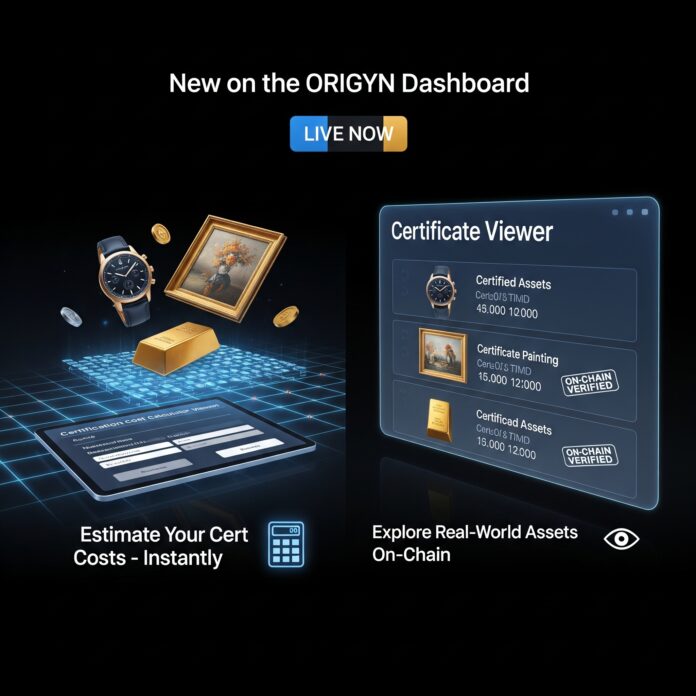The people at ORIGYN have just added two new tools to their dashboard, and they’re making real-world assets a whole lot easier to understand on-chain. It’s not a sweeping overhaul, but it is the kind of subtle upgrade that cuts through friction and gives users the clarity they’ve been quietly asking for. Whether you’re trying to certify a luxury item or just see how others are doing it, the dashboard now has two handy features: a Certification Cost Calculator and a Certificate Viewer. And while they might sound like dry widgets at first, both tools speak directly to some of the most persistent questions in tokenising physical things.
The Certification Cost Calculator does exactly what the name suggests: it lets you plug in your asset details and see, upfront, what it’ll cost to bring them on-chain using ORIGYN’s framework. For anyone who’s hesitated at the thought of onboarding a collection—whether it’s watches, art, or anything else—the guesswork’s now gone. Just put in how many items you want to certify, decide whether you need hosting, storage, or any added features, and get an instant readout of the cost. It’s the kind of small shift that makes decision-making easier for both individuals and organisations.
The idea behind the calculator is simple: let people model their needs before they commit. And the execution is equally straightforward. You don’t need to book a demo, read long documents, or ask someone in the community for rough estimates. The calculator sits directly on ORIGYN’s dashboard at dashboard.origyn.com/calculator, ready for use. It feels like one of those features that should have always been there, and now that it is, it brings a bit more confidence into the onboarding process.
Then there’s the Certificate Viewer. This one’s less about estimating and more about exploring. The Viewer gives anyone the ability to browse real-world assets that have already been certified using ORIGYN’s protocol. These aren’t placeholders or off-chain mock-ups. Each certificate shown is hosted fully on-chain, and all metadata is visible. Whether you’re curious about tokenised gold, vintage timepieces, or fine art NFTs, the Viewer gives you a way to check them out without needing any behind-the-scenes access.
The idea is to give transparency to the broader certification process—and to let anyone see what’s actually happening on the protocol in real time. For people outside the space, it works as an easy demo of what tokenised authenticity looks like. For those inside it, it doubles as a tool to benchmark quality, see how different categories are handled, and track the growth of certified assets over time.
Taken together, both tools reflect a shift towards usability that feels very much on-brand for ORIGYN. While some platforms in the Real-World Asset space lean into exclusivity or technical barriers, this release suggests a different approach. One that invites participation by being upfront about cost, clear about what’s already working, and confident enough to make the process public. This is especially important as the broader RWA conversation starts to heat up. The idea of tokenising physical items isn’t new, but making that process understandable—both in theory and in cost—is still something a lot of projects are working on. These two dashboard updates help push ORIGYN further in that direction.
There’s also something refreshingly minimal about the rollout. No unnecessary bells, no bloated marketing language, no vague promises. Just two tools that answer two core questions: What will it cost? What does a certified asset actually look like? Sometimes that’s all people want to know. And now, they can find out with a couple of clicks.
The on-chain hosting of certificates is worth a mention on its own. It’s a key feature that distinguishes ORIGYN’s protocol from others that rely on hybrid or centralised solutions. By keeping everything—from metadata to the certificate record—on-chain, the protocol ensures that the transparency isn’t just for show. It’s functional, persistent, and accessible without middlemen. That’s a technical choice that ends up having very human consequences. It builds trust.
And trust is ultimately what ORIGYN is selling. The blockchain layer might be advanced, the NFTs might be sleek, but the heart of the offer is simple: authentic digital proof that a real-world item is what it says it is, and that it belongs to whoever holds the certificate. These two new tools don’t try to reinvent that promise. They just help make it easier to act on it.
What ORIGYN’s doing here fits into a larger pattern among Internet Computer-based projects: a slow and steady layering of functionality that brings concepts closer to actual usage. The RWA conversation has, at times, been full of lofty ideas and big-picture language. This is the opposite. It’s practical. If you’ve got an asset, here’s what you’ll pay. If you want to see certified assets, here they are. There’s no need to interpret anything. It’s all laid out.
It’s easy to imagine how this could feed into other developments too. For example, the Viewer might become a useful tool for buyers or investors doing due diligence on-chain. Or the Calculator could be expanded to support batch estimates for enterprises looking to tokenise full inventories. There’s plenty of scope for growth, but what’s there today already makes a noticeable difference to how people interact with the dashboard.
As with most things ORIGYN, the tech sits quietly in the background. You don’t need to understand the Internet Computer or the intricacies of NFT standards to use either feature. The dashboard abstracts all of that, letting users focus on the assets themselves. This speaks to a broader design philosophy that seems to be guiding the project—one that values clarity over complexity, and participation over posturing.
With these additions, ORIGYN has tightened the loop between curiosity and action. If you’ve ever wondered what tokenised assets look like, or thought about certifying your own, there’s now a clear place to start. That’s good news for creators, collectors, and companies alike. And perhaps most importantly, it brings real usability to a space that’s often accused of being too abstract.
Whether you’re certifying a single painting or hundreds of watches, there’s now a tool to help you estimate costs and a viewer to help you learn from what’s already been done. Both are now live. No need for a sign-up. No need for a technical walkthrough.
Just straight answers to practical questions. ORIGYN, quietly, is setting a new standard.
Dear Reader,
Ledger Life is an independent platform dedicated to covering the Internet Computer (ICP) ecosystem and beyond. We focus on real stories, builder updates, project launches, and the quiet innovations that often get missed.
We’re not backed by sponsors. We rely on readers like you.
If you find value in what we publish—whether it’s deep dives into dApps, explainers on decentralised tech, or just keeping track of what’s moving in Web3—please consider making a donation. It helps us cover costs, stay consistent, and remain truly independent.
Your support goes a long way.
🧠 ICP Principal: ins6i-d53ug-zxmgh-qvum3-r3pvl-ufcvu-bdyon-ovzdy-d26k3-lgq2v-3qe
🧾 ICP Address: f8deb966878f8b83204b251d5d799e0345ea72b8e62e8cf9da8d8830e1b3b05f
🪙 BTC Wallet: bc1pp5kuez9r2atdmrp4jmu6fxersny4uhnaxyrxau4dg7365je8sy2q9zff6p
Every contribution helps keep the lights on, the stories flowing, and the crypto clutter out.
Thank you for reading, sharing, and being part of this experiment in decentralised media.
—Team Ledger Life


